Argentinos Juniors
Asociación Atlética Argentinos Juniors is an Argentine sports club based in La Paternal, Buenos Aires. The club is mostly known for its football team, which currently plays in the Argentine Primera División, and was recognized as one of the most important football teams of South America by FIFA.[1] It is one of the eight Argentine first division teams that have won the Copa Libertadores. The continental trophy was won in the club's first entry to the contest, in 1985. The most remarkable sign of this team is the power of its youth teams, which unveiled some of the most talented footballers in Argentinian football history, with Diego Maradona as the greatest example of all. As a result it has been described as "one of Argentina's most distinctive football clubs".[2][3]
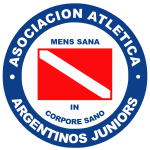 | ||||
| Full name | Asociación Atlética Argentinos Juniors | |||
|---|---|---|---|---|
| Nickname(s) | El Bicho (The Bug) El Semillero del Mundo (World's Seedbed) El Tifón de Boyacá (The Boyacá Typhoon) | |||
| Founded | 15 August 1904 | |||
| Ground | Diego A. Maradona, La Paternal, Buenos Aires | |||
| Capacity | 26,000 | |||
| Chairman | Cristian Malaspina | |||
| Manager | Diego Dabove | |||
| League | Primera División | |||
| 2018–19 | 26th | |||
| Website | Club website | |||
|
| ||||
History
Early years
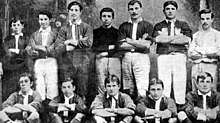
The club was founded in the Villa Crespo neighbourhood of Buenos Aires on 14 August 1904, by a group of anarchist boys that were part of club "Mártires de Chicago" (chosen in homage to the eight anarchists imprisoned or hanged after the 1886 Haymarket Riot in Chicago).[4] Leandro Ravera Bianchi was named president of the recently created club.
The club immediately adopted the red and white colors as an homage to deputy Alfredo Palacios, the first congressman elected from the Socialist Party in Argentina. The club affiliated to Liga Central de Football, a minor league which small clubs and companies took part of. The first match played by Argentinos Juniors was against Club La Prensa, which it lost by a catastrophic scoreline of 12–1. Nevertheless, the squad would crown champion at the end of the season. Argentinos Juniors played its home matches in the field located on Gaona Avenue and Añasco street.
After the club was evicted, Argentinos Juniors played in several fields, first renting one in Villa Ballester, returning to their neighborhood of origin in 1907. After a brief stunt in Villa Urquiza, the club returned to Caballito, then moving to Fraga and Estomba streets in Villa Ortúzar. In 1909 Argentinos gained affiliation with the Argentine Football Association, but in 1912 the club was involved in the first schism in Argentine football when Argentinos joined the breakaway "Federación Argentina de Football" (FAF). During those years, the club re-adopted the green and white colors due to there were other teams with red jerseys.
In 1920 Argentinos played a promotion playoff with El Porvenir but it lost 3–2 on aggregate. In 1921 the team secured promotion to the top division, making its debut in the 1922 season, where Argentinos finished 6th.
Argentinos Juniors was definitely settled up in La Paternal neighborhood in 1925, where the club acquired a land on San Martín Avenue and Punta Arenas street to build a stadium with a capacity of 10,000. With the new stadium finished, Argentinos Juniors was runner-up in 1926 behind champions Boca Juniors. The club had also increased its number of members to 1,000.
In 1927 the two separate football associations were reunified and Argentinos played in a massive 34 team league. Later, the league was expanded to 36 and Argentinos managed to keep its place until 1930.
1931–1966
In 1931 Argentinos joined 17 other clubs in forming a breakaway professional league, a move that marked the beginning of the professional era of Argentine football. In 1934 the amateur league was broken up and Argentina once again had a unified first division. As part of this move, Argentinos Juniors were unified with Club Atlético Atlanta, the season progressed badly, and after 25 rounds the union was dissolved due to financial irregularities in the Atlanta books. Argentinos Juniors played on but finished bottom of the league with only 2 wins from 39 games.
Argentinos was allowed to keep its place in the Primera, but succumbed to relegation in 1937 after finishing second from bottom of the table.
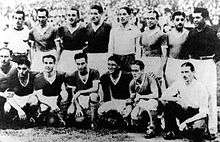
In 1940 Argentinos enjoyed a good campaign in a new stadium, which culminated in winning the 2nd division,[5] but the club were not allowed promotion because their ground did not meet the requirements of the Primera División, and AFA would not make an exception for Argentinos to play at another ground, even though they had done so for several other promoted clubs in previous seasons.
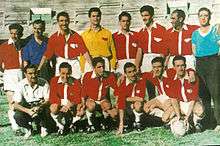
In 1943 Hector Ingunza made his first appearance for the club, and went on to become the top scorer in the club's history with 143 goals in official games between 1943 and 1946.
In 1948 Argentinos suffered another injustice at the hands of the AFA. They had qualified to the end of season playoff for promotion to the Primera and were top of the league after 7 of the 11 rounds when a players strike interrupted the competition. AFA eventually abandoned the playoff and gave automatic promotion to the teams that had been relegated in 1946 and 1947 instead.
In 1954 Argentinos finished 2nd in the league having scored 88 goals, making it the highest scoring team by far. In 1955 the team finally secured promotion back to the Primera after 18 long years. Argentinos returned to top flight competition in 1956 and after finishing near the bottom of the table that year, the team secured comfortable mid-table finishes over the next few seasons.
In 1960 there was a complete overhaul of the Argentinos Juniors team. The new team performed well and it was only on the last game of the season that they missed out on the championship. Argentinos finished in 3rd place, only 2 points below the eventual champions Independiente. Although the team didn't win the championship, it is fondly remembered by those old enough to have seen them play.[6] In the following years the team did not live up to expectations, rarely finishing in the top half of the table.
1967–1984
1967 saw the introduction of the Metropolitano and Nacional system, Argentinos struggled to adapt and only just survived relegation from the Metropolitano in the inaugural season. Over the next few seasons Argentinos had to play in several short tournaments to earn the right to stay in the Metropolitano and were far from qualifying to play in the Nacional.
From 1971 Argentinos stabilized themselves and avoided the lower positions in the table, they also qualified to play in the expanded Nacional tournaments of the early '70s, they performed well enough, but failed to qualify for the final stages.
In 1975 Argentinos Juniors finished 19th of 20 teams, but were extremely fortune in that no teams were relegated from the Metropolitano that season.
On Thursday 20 October 1976, fans of Argentinos Juniors and a few traveling Talleres fans witnessed probably the most important debut in the history of Argentine football. With Argentinos losing 1–0 the manager, Juan Carlos Montes sent on a fifteen-year-old debutant named Diego Armando Maradona making him the league's youngest ever player until his record was broken by Sergio Agüero in 2003. Argentinos lost the game but Diego went on to propel the club forward over the next four years and to achieve great successes with other clubs and the Argentina national team. In the 1979 Metropolitano Diego became the youngest topscorer in the history of Argentine football with 14 goals, he went on to become top scorer in the following three tournaments, matching José Sanfilippo's record of being Argentina's topscorer on four consecutive occasions. In 1980 Argentinos finished 2nd in the Metropolitano and reached the quarter finals of the Nacional. The 2nd-place finish was their best since the beginning of the professional era in 1931.
Maradona was sold to Boca Juniors in 1981 for a fee of £1 million. Maradona never won a title with Argentinos but his massive transfer fee allowed Argentinos to strengthen their squad for the years ahead, although his departure almost cost Argentinos their place in the top flight as they needed a last day win over San Lorenzo to avoid relegation at San Lorenzo's expense.
In 1982 Argentinos failed to progress to the latter stages of the Nacional and finished in mid table in the Metropolitano. The season of 1983 saw a distinct improvement under the leadership of Ángel Labruna, he had brought in a new group of players a new system of play and moved them to the Estadio Ricardo Etcheverry of Ferro Carril Oeste to give the team a wider pitch to play on. The team were making good progress, they had made it to the semi-finals of the Nacional and were in the middle of the Metropolitano when Labruna died suddenly on 20 September 1983, the team held themselves together under new manager Roberto Saporiti for a mid table finish. They then made it to the quarter-finals of the Nacional in 1984.
1984–1985: First titles and Copa Libertadores
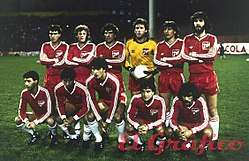
Saporiti had kept faith with Labruna's attacking style of play, and largely retained the same group of players. Argentinos managed to win the title by a single point over Ferro Carril Oeste on the last day of the season. This was the first major title in the club's history and gave them automatic qualification to the Copa Libertadores in 1985.
Saporiti was replaced as manager by José Yudica who had worked wonders in previous seasons including leading unfashionable Quilmes Atlético Club to the Metropolitano championship in 1978 and rescuing San Lorenzo from the 2nd division at the first time of asking. The Nacional championship of 1985 was the last, and featured by far the most complicated structure in the history of the Argentine Primera. Once the competition reached the knockout stage, the eliminated teams got another chance to play on in the losers knockout. Argentinos won the winners group with a 4–2 penalties win against Vélez Sársfield after a 2–2 aggregate score, but Velez got another chance to play for the title after beating River Plate in the losers final. Argentinos and Velez played for the title and after a 1–1 draw, Velez won the penalty shootout, but because they had come from the losers group a new game was needed, which Argentinos won 2–1.
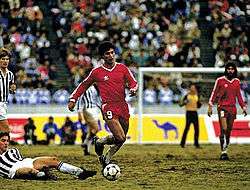
The 1985 edition of the Copa Libertadores saw the inclusion of three Argentine teams, Independiente as the previous years champions, Ferro Carril Oeste as the champions of the 1984 Nacional and Argentinos Juniors as the champions of the 1984 Metropolitano.
In the first round Argentinos and Ferro were put into the same group with Brazilian teams Fluminense and Vasco da Gama. The group was dominated by the two Argentine teams, who finished level on points at the top of the group. This necessitated a playoff game to determine which team would progress to the semi-final, which Argentinos won 3–1.
In the semi-final round Argentinos found themselves in a group of three with Independiete who had received a bye to the semi-finals and club Blooming of Bolivia. Argentinos progressed thanks to a 2–1 win in Independiente's stadium in the last fixture of the group.
The final was against América de Cali of Colombia, after a 1–0 home win each, the final went to a deciding game in Asunción, Paraguay. The game finished 1–1 and Argentinos won 5–4 on penalties. It was only the second time the competition had been decided on penalties, and marked the finest achievement in the history of Argentinos Juniors.
The usual line-up was: Enrique Vidallé, Carmelo Villalba, José Luis Pavoni, Jorge Olguín, Adrián Domenech, Emilio Commisso, Sergio Batista, Mario Videla, "Pepe" Castro, Claudio Borghi, Carlos Ereros. The team was coached by José Yudica.
Decline
In 1985 Argentinos Juniors represented South America in the Intercontinental Cup against Juventus F.C. of Italy, the game ended in a 2–2 draw, but Argentinos lost in the penalty shootout. Argentinos went on to win another trophy in 1986. They won 1–0 in the Copa Interamericana against Defence Force of Trinidad and Tobago.
Argentinos qualified for the 1986 Copa Libertadores, receiving a bye to the second round as holders, but was eliminated in the group of three, behind River Plate of Argentina who went on to win the tournament.
1985–1986 saw the start of European-style seasons. Argentinos performed well, finishing in the top half of the table for most of the rest of the 1980s and never fearing relegation, although Argentinos also never really challenged as title contender. By 1988 the majority of the Libertadores champions had gone and Argentinos were a vastly different team.
On 20 November 1988 the club set a world record for the longest penalty shootout, which occurred in a league match against Racing Club, the shootout finished 20–19 to Argentinos after 44 penalties were taken. The rules of the time granted an extra point for the winner on penalties after a drawn match.
1990 saw the introduction of the Apertura and Clausura system in Argentina, Argentinos enjoyed a number of decent finishes, although the team finished 19th in Apertura 1992 and was saved from relegation by the points averaging system.
Relegation and return to Primera
Argentinos finished 20th and last in 1995 Clausura and was again saved by the points averaging system, the next year squad finished bottom of the Clausura and was relegated from the Primera División only eleven years after being champions of South America.
In the 1996–1997 season Argentinos won the second division under manager Osvaldo Sosa to bounce back into the Primera at the first attempt. The team remained in the top flight until it was relegated again after another sequence of poor finishes. The best finish Argentinos managed in that period was 4th in the 2001 Clausura.
Argentinos spent two seasons in the 2nd division before returning in 2004 through a playoff with Talleres de Córdoba who had finished the season in 3rd place in the Primera, but had to play in the relegation playoff due to effect of their poor form in the previous 2 seasons on their standings in the points averaging table.
Argentinos spent a couple of nervous seasons narrowly avoiding relegation in 2005 by beating Atlético de Rafaela in a playoff. The following season it survived a playoff against Huracán. The 2006–2007 season saw Argentinos finally claw its way clear from the relegation places after over two years of flirting with relegation.
In 2008 Argentinos earned the right to play in an international tournament for the first time in 12 years by qualifying for the Copa Sudamericana 2008. The team eventually progressed to the semi-final where it was eliminated by Estudiantes de La Plata over two legs despite beating them 5–0 in the league game which was sandwiched between the cup ties.
In June 2009, former star player Claudio Borghi took over as manager of the club following a poor performance in the 2009 Clausura tournament where the club had finished 20th and last in the table with only 2 wins from their 19 games.
At the beginning of the Clausura 2010 championship, Argentinos set itself the target of matching or improving on the 61 points from the 2007–08 season to avoid dropping further down the relegation table.
The team recorded an impressive 6–3 win against Lanús in its second fixture of the campaign, but after 5 games this would be its only victory, with two draws and two defeats. Argentinos won its 6th fixture against Estudiantes de La Plata which was the start of a 14-game unbeaten streak that saw Argentinos finish 1-point ahead of Estudiantes at the end of the season. The most significant result in this 14 game run was in the penultimate fixture against title challengers Independiente, which saw Argentinos come back from 1–3 down to win 4–3, which featured two goals in the final minutes of the game to seal the win and leave Argentinos at the top of the table with one game to play. Argentinos finally won its first domestic championship in 25 years with a 1–2 away win against Huracán in the Estadio Tomás Adolfo Ducó.
In April 2014, they were relegated to the Primera B Nacional.
Kit uniform evolution
Although the red color has been historically identified with Argentinos Juniors, the first jersey was green with white vertical stripes. Some sources state that this jersey was worn during the first years of the team because the Argentine Football Association did not allow Argentinos Juniors to register a red uniform due to it having been previously adopted by Club Atlético Independiente.[7]
Main uniform
1904–17 |
1917–present [note 1] |
Players
Current squad
- As of 21 March 2020.[9]
Note: Flags indicate national team as defined under FIFA eligibility rules. Players may hold more than one non-FIFA nationality.
| No. | Pos. | Nation | Player |
|---|---|---|---|
| 2 | DF | Miguel Ángel Torrén | |
| 3 | DF | Kevin Mac Allister | |
| 4 | DF | Agustín Aleo (on loan from Godoy Cruz) | |
| 5 | MF | Francis Mac Allister | |
| 6 | DF | Marcos Angeleri | |
| 7 | FW | Victorio Ramis (on loan from Godoy Cruz) | |
| 8 | MF | Iván Colman | |
| 9 | FW | Santiago Silva | |
| 10 | MF | Damián Batallini | |
| 11 | MF | Tomás Andrade (on loan from River Plate) | |
| 12 | GK | Lucas Chaves | |
| 13 | DF | Maximiliano Centurión | |
| 14 | MF | Gabriel Florentín | |
| 15 | DF | Jonathan Sandoval | |
| 16 | DF | Carlos Quintana | |
| 17 | MF | Franco Moyano (on loan from San Lorenzo) |
| No. | Pos. | Nation | Player |
|---|---|---|---|
| 18 | MF | Diego Sosa | |
| 19 | MF | Matko Miljevic | |
| 20 | MF | Fausto Vera | |
| 21 | DF | Matías Caruzzo | |
| 23 | FW | Edwar López | |
| 24 | DF | Elías Gómez (on loan from Rosario Central) | |
| 25 | FW | Mateo Coronel | |
| 26 | MF | Matías Romero | |
| 27 | FW | Gabriel Hauche | |
| 28 | FW | Nicolás Silva | |
| 29 | FW | Lucas Ambrogio | |
| 30 | MF | Fausto Montero | |
| 31 | GK | Miguel Acosta | |
| 32 | FW | Agustín Aleo | |
| 33 | GK | Leandro Finochietto | |
| 34 | GK | Nicolás Forastiero |
Out on loan
Note: Flags indicate national team as defined under FIFA eligibility rules. Players may hold more than one non-FIFA nationality.
| No. | Pos. | Nation | Player |
|---|---|---|---|
| — | GK | Federico Lanzillotta (to Palestino until 30 June 2020) | |
| — | DF | Jonathan Galván (to Central Córdoba until 30 June 2020) | |
| — | DF | Enzo Ybáñez (to Godoy Cruz until 30 June 2020) | |
| — | FW | Gastón Verón (to Palmeiras until 30 June 2020) | |
| — | MF | Leandro Paiva (to Atlante until 30 June 2020) |
| No. | Pos. | Nation | Player |
|---|---|---|---|
| — | FW | Enrique Borja (to Belgrano until 30 June 2020) | |
| — | DF | Leonel Mosevich (to Nacional (M) until 30 June 2020) | |
| — | MF | Francisco Metilli (to Estudiantes (BA) until 30 June 2020) | |
| — | MF | Nahuel Rodríguez (to Brown (A) until 30 June 2020) |
Notable players
To appear in this section a player must have played at least 50 games for the club or set a club record
|
|
|
Former coaches
|
|
|
Presidents
|
|
|
Stadium
The club currently plays in the Estadio Diego Armando Maradona which is also often referred to as La Paternal after the La Paternal district of Buenos Aires where the club is based. The stadium was named after Diego Maradona because he started his career in the Argentinos youth team. Between 1983 and 2003 Argentinos had a groundshare with Ferro Carril Oeste at Estadio Ricardo Etcheverry. The club has had a number of other homes in its history, all based in the city of Buenos Aires.
Nicknames
The club, which is nicknamed Bichos Colorados (Red Bugs), is one of the most prolific sources of football players in Argentina. Diego Maradona, Fernando Redondo and Juan Román Riquelme being some of the most famous players who began their career at the club. This ability to keep producing world class players has given them the nickname El Semillero, meaning the Nursery or the "Seed Garden".
Honours
National
- Primera División (3): 1984 Metropolitano, 1985 Nacional, 2010 Clausura
- Primera B Nacional (2): 1996–97, 2016–17
- Primera B (3): 1940,[note 1] 1948,[note 1] 1955
International
- Copa Libertadores (1): 1985
- Copa Interamericana (1): 1986
- Notes
- Although having won the championship, the team did not earn promotion to Primera División.
References
- FIFA.com. "FIFA - FIFA.com". www.fifa.com.
- "Argentinos Juniors: The 'Argentinean Ajax' where Diego Maradona emerged". 2 May 2019 – via www.bbc.co.uk.
- "Argentinos Juniors". worldfootball.net. Retrieved 11 January 2020.
- "Argentina's soccer passion". Znet Online. 28 June 2006. Archived from the original on 7 August 2007. Retrieved 24 July 2007.
- RSSSF.com Archived 2 November 2007 at the Wayback Machine, Argentine 2nd level 1940
- Argentinos Juniors official website Archived 18 October 2007 at the Wayback Machine
- El Nacimiento de una Pasión, Alejandro Fabbri – Capital Intelectual ediciones (2006)
- Argentinos Juniors official website Archived 18 October 2007 at the Wayback Machine
- "Argentinos Juniors squad". Argentinos Juniors. Retrieved 21 March 2020.
- "Archived copy". Archived from the original on 24 December 2013. Retrieved 6 November 2013.CS1 maint: archived copy as title (link)
- "Alfredo Berti, el sucesor de Heinze en Argentinos". TyC Sports. 4 August 2017. Retrieved 6 August 2017.
External links
| Wikimedia Commons has media related to Asociación Atlética Argentinos Juniors. |
- Official website

- Argentinos Juniors at RSSSF
- AAAJ.com.ar
- Argentinos Pasión
- Pasión Paternal
- Argentinos de Primera
- Bichos Colorados, El museo Virtual
